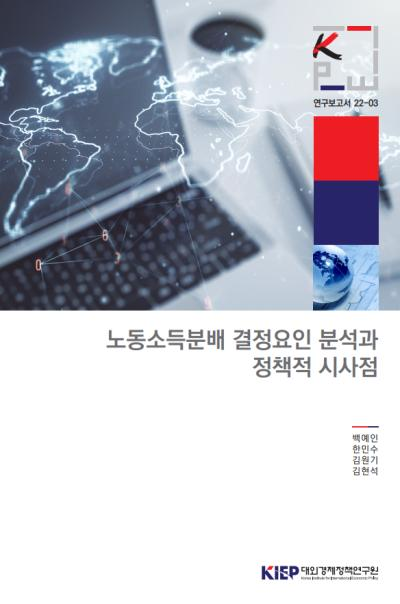Working Papers
Publications
Working Papers
To list

Analysis on the Determinants of Labor Share and Its Policy Implications
economic integration, labor market
Author Yaein Baek, Minsoo Han, Wongi Kim, and Hyunsuk Kim Series 22-03 Language Korean Date 2022.12.30
The global decline of labor income share has spurred numerous studies investigating the cause of its drop. As decrease in labor share might imply aggravating income inequality, it has been used as one of the main indicators of inequality. Not only is labor income the main source of income for low-income class including the self-employed, but its decline could disproportionately affect low-skilled workers within wage earners. This study analyzes the determinants of the changes in labor share. As technological changes such as adoption of robots, advancements in ICT and the Fourth Industrial Revolution are expected to alter the labor market, we analyze the impact of such technical changes on labor share and derive policy implications.
This study mainly consists of four parts. In Chapter 2, we estimated the trend of Korea’s labor income share and examined changes in its components. We addressed the measurement issue of income for the self-employed in two ways. First, we applied various methods proposed in previous studies to macro data and analyzed the adjusted series. Second, we separately estimated labor share using firm-level micro data in which measurement issues do not arise. Main takeaways from these analyses are summarized as follows. First, the level and trend of the labor share in Korea changes greatly when we adjust for the earnings from the self- employed. Most importantly, unlike the traditional measure of labor share, the adjusted series exhibit a downward trend from the mid-1990s to the period of global financial crisis. The difference arises due to relatively stagnant operating surplus of private unincorporated enterprises (OSPUE) compared to rising total employee compensation. Second, short-term changes in labor share are mainly attributed to fluctuations in capital income rather than components of labor income (employee compensation and OSPUE). In particular, fluctuations in net operating profit drive variations in the labor share across time and industries. Third, statistics from various international organizations show that Korea’s overall labor income share has been relatively higher than those of other countries, but the gap is narrowing due to declining share of self-employed workers.
In Chapter 3, we examine whether the determinants of labor share suggested in previous studies such as technological change, globalization, population and education indicators are meaningful as predictors. We estimate a regression tree model, which is a machine learning method, for forecasting labor share and obtain variables with predictive power. There are three main takeaways as a result of analyzing the regression tree model of developed and emerging countries. First, in forecasting the labor share in the corporate sector in six developed countries, human capital and the relative price of investment goods are found to be the most important. In addition, the non-linear relationship between human capital and the relative price of investment goods can be important in predicting the labor share. Second, human capital and education are important in predicting the labor share in developed countries, whereas demographic change and ICT development play a key role in emerging countries. Third, human capital is important in 5 out of 8 developed countries, and the importance of ICT change varies across countries. In short, it was found that human capital and education are important not only as determinants, but also as predictors of the changes in labor share. In addition, changes in technology, such as ICT, are also important predictors in both advanced and emerging countries.
In Chapter 4, we examine the impact of robots on the labor market by conducting empirical analyses with two different data sets. The first analysis estimates the effect of robots on labor share and labor productivity using panel regression on industry-country level data. We merge data from KLEMS and the International Federation of Robots (IFR) to obtain data of 15 industries from 17 countries. The second analysis studies the impact of the 4th industrial revolution, including the adoption of robots and AI, on labor share and labor productivity at the firm level. We apply panel regression using Survey of Business Activities from Statistics Korea. The results from both data sets show that the introduction of robots lowers the labor share. Also, as robot adoption increases, labor productivity tends to improve. Previous studies suggest that the introduction of robots may reduce employment by replacing labor (substitution effect) but also increase employment and productivity by lowering production costs (productivity effect). Our findings of improvement in labor productivity and decline of labor share are consistent with these observations, and suggest that the substitution effect might be stronger than the productivity effect.
Based on the results from previous chapters, Chapter 5 discusses policy implications along dimensions of labor, education, and industry. The policy measures are focused on supporting the acquisition and management of human capital in a rapidly shifting technological environment. According to our empirical analyses, technological progress tends to benefit primarily high-skilled workers, while resulting in job losses for low-skilled workers. This calls for timely reallocation of labor in response to technological change at institutional level, so we suggest three policy directions. First, vocational training and lifelong education system improved so that workers can adapt to new environment at the workplace. Second, it is necessary to continue enhancing labor market flexibility and the dynamism of the corporate sector while maintaining a strong social safety net. Lastly, it is also important to check the overall governance of the administrative and legal system for proper implementation of these policies.
Sales Info
| Quantity/Size | 150 |
|---|---|
| Sale Price | 7 $ |
 공공저작물 자유이용허락 표시기준 (공공누리, KOGL) 제4유형
공공저작물 자유이용허락 표시기준 (공공누리, KOGL) 제4유형
대외경제정책연구원의 본 공공저작물은 "공공누리 제4유형 : 출처표시 + 상업적 금지 + 변경금지” 조건에 따라 이용할 수 있습니다. 저작권정책 참조
